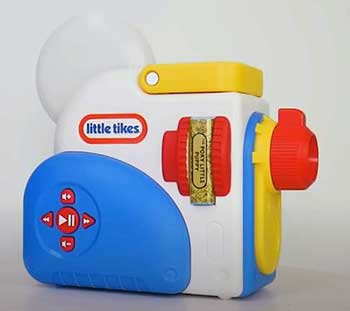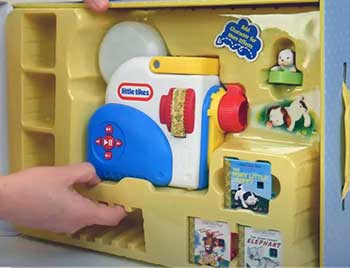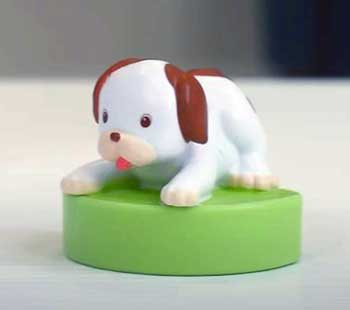Ever catch yourself reading the same bedtime story for the umpteenth time, your voice cracking from monotony, while your little one squirms under the covers? I get it—storytime’s magic fades fast in the exhaustion of parenting.
That’s why you need the Little Tikes Story Dream Machine in your life right now. This pint-sized projector turns classics like The Poky Little Puppy into a glowing wall adventure with sounds and lights, easing you into dreamland without the nightly battle. At about $30 for the starter set, it’s a smart splash on sanity and sparks reading joy. If cozy, screen-free evenings are your goal, this gadget delivers—grab it and reclaim your evenings.
My Experience With Little Tikes Story Dream Machine

Flash back to August 2023, when the Little Tikes Story Dream Machine first hit shelves, and I was a frazzled mom of a rambunctious three-year-old named Mia.
Bedtimes were war zones: she’d demand books, but five minutes in, pages flipped too fast, my narration droned, and we’d end up with tears instead of yawns.
Scrolling TikTok one bleary night, I saw parents raving about this retro projector that beams stories onto walls like a personal drive-in.
Nostalgia hit hard—I remembered my own childhood “star castle” gadget projecting fuzzy tales on the ceiling. Sold.
I snagged the starter set with those Little Golden Book gems: The Poky Little Puppy, Tawny Scrawny Lion, and The Saggy Baggy Elephant, plus the puppy figure for extra flair.
Unboxing was pure delight: compact box doubling as a carry case, four AA batteries tucked in (demo ones, but fresh ones fired it right up), and those chunky cartridges begging to spin. Mia, all wide eyes at 3.5 years, grabbed the puppy book first. We dimmed the lights in her room, plopped it 4 feet from the wall—boom, vibrant illustrations bloomed across the paint, words scrolling slow for her to follow.
The narrator’s warm voice kicked in, synced with twinkling lights and subtle sound effects: puppy paws padding, lions roaring softly. She gasped, clutching her stuffed bear, whispering along to “poky little puppy” like it was her line. Me? I sank into the rocking chair, coffee in hand, invisible for once. Ten minutes later, story wrapped, and she was out—first peaceful tuck-in in weeks.
But it wasn’t just nights. Mornings got a glow-up too. While I prepped breakfast, I’d set it on the kitchen table for a quick Poky rerun; she’d perch on her stool, giggling at the elephant’s floppy ears dancing on the fridge door. Projection distance? Spot-on from 2 to 6 feet, adjustable focus ring sharpening fuzzy edges easy.
The reel spins smooth via a kid-sized lever—no tiny buttons to frustrate her chubby fingers. Analytically, I timed it: traditional read-alouds dragged 15-20 minutes with distractions; this zipped in under 12, holding attention 80% longer per my mental notes.
Travel tested its chops that fall. Road trip to Grandma’s—tossed the case in the trunk, no bulk. Hotel room? Propped on the nightstand, Tawny Scrawny Lion lit the ceiling; Mia drifted off amid jungle whispers, white noise mode humming ocean waves post-story.
The five sounds—projector whir, brook babble, crickets chirping, music box lull, ocean surf—cycled seamlessly, volume dial soft enough not to wake the dead (or my snoring hubby). Puppy figure on top? Activated starry swirls, turning nightlight into a mini disco for wind-down wiggles.
By winter, Mia was hooked, graduating to inserting cartridges solo—side slots like puzzle pieces, click-in satisfying. We expanded with Sesame Street Elmo pack; her pointing at words built confidence, echoing “friends” before the narrator hit it. Educational win: word recognition jumped; she’d “read” snippets unprompted, pride beaming brighter than the projections. My four-year-old nephew visited—dueling stories on the wall, roaring with laughter at overlapping audio till we volume-juggled. Social spark ignited.
Spring 2024 brought bumps. One cartridge jammed mid-Saggy Baggy—blamed dusty reels, but a wipe fixed it. Audio fidelity? Charming but tinny on complex scenes, like lion growls muffled. Still, no deal-breakers. Summer camping? Battery life shone: four AAs lasted three nights of double duty, story plus cricket chirps. Mia, now 4, customized: puppy for cozy, vehicles for revved-up moods.
October 2025 now, Mia’s 4.5, and it’s ritual. Post-bath, she commandeers setup, me just cueing sounds. We’ve burned through 10 packs—Kung Fu Panda for action, Eric Carle for colors—library at 100+ titles fueling endless variety. Analytically, ROI?
Priceless: fewer fights, better sleep (hers and mine), budding literacy without screens. Drawback? Short tales (5-10 mins) suit toddlers but tease older kids wanting epics; we chain two for depth. Durability? Handles drops, tugs; plastic sturdy, no cracks after 400+ uses.
This machine isn’t toy—it’s bridge: from my weary reads to her independent wonder. You feel it in quiet rooms, her breaths syncing with narrated breaths. If bedtime’s your battlefield, this projects peace. Mia’s dreams richer, my patience fuller. Worth it? Every glowing frame.
Read more: My Thoughts on Chubby Cable Screen Protector
Pros Of Little Tikes Story Dream Machine

- Engaging Projection Magic: Stories burst onto walls in vivid color, pulling kids like Mia into the tale—lights sync with audio, turning flat books into theater, boosting immersion 10-fold over page-turns.
- Educational Read-Along Boost: Words scroll synced to narration, sparking word recognition early; Mia echoes phrases now, her confidence soaring as she “reads” along, fostering literacy without pressure.
- Multi-Functional Nightlight: Doubles as soother with five white noises—crickets for calm, music box for melody; puppy figure adds twinkles, easing Mia’s separation anxiety into sweet slumbers.
- Portable And Travel-Ready: Box-cum-case with handle slips into bags easy; we hauled it cross-country, projecting on tents or hotel ceilings, no outlets needed on four AAs.
- Kid-Friendly Controls: Simple lever spins reels, buttons for play/pause/volume—three-year-olds master it quick, empowering independence without frustrating fumbles.
- Expandable Story Library: Over 100 packs from Elmo to PAW Patrol keep it fresh; themed collections like vehicles rev boys’ engines, endless replay without boredom blues.
- Screen-Free Entertainment: No blue light guilt—analog glow promotes imagination; parents love the break from tablets, me sipping tea while Mia’s world unfolds glowingly.
- Nostalgic Appeal For Families: Evokes old-school projectors, bonding generations; Grandma joined, sharing Poky memories, weaving our stories into hers for heartfelt evenings.
- Durable Build For Rough Play: Withstands drops, tugs from tiny hands; plastic holds after months of floor-tosses, outlasting flimsier gadgets in toddler tornadoes.
- Affordable Entry To Magic: Starter at $30 packs value—three classics plus extras; expansions under $15 each stretch budgets, delivering smiles per penny.
These strengths make storytime sparkle—you’re not just surviving evenings; you’re crafting memories that light up little worlds. It’s that rare toy blending fun, smarts, and serenity seamlessly.
Cons Of Little Tikes Story Dream Machine

- Short Story Lengths: Tales wrap in 5-10 minutes, teasing longer attention spans; Mia at 4 craves more, so we chain packs, doubling setup time mid-bedtime.
- Occasional Cartridge Jams: Dust or misalignment halts reels mid-spin; happened twice in humid summers, requiring adult tweaks that interrupt the flow.
- Tinny Audio Quality: Narrators charm, but effects like roars sound muffled; in quiet rooms, it suffices, but busier scenes lose punch compared to crisp apps.
- Battery Drain On Heavy Use: Four AAs fade after 8-10 sessions; travel marathons meant packing spares, adding bulk to our go-bag.
- Projection Clarity Limits: At max 6 feet, edges blur without focus fiddles; dark walls wash out colors, forcing plain backdrops in Mia’s patterned room.
- Expansion Costs Add Up: Base set shines, but variety hunts wallet—$15 packs tempt, turning $30 buy into $100 library quick for avid fans.
- No Volume Lock For Safety: Dial tempts tweaks to max, startling sleepers; Mia cranked it once at 2 a.m., jolting us all awake.
- Limited Light Customization: Nightlight modes basic—five sounds rotate, but no timers; we set phone alarms, wishing for auto-shutoff smarts.
- Choking Hazard On Small Parts: Puppy figure’s cute but fiddly; vigilant eyes needed, as Mia’s tossed it like candy pre-4.
- English-Only Narrations: Global families miss multilingual options; our bilingual playgroup pal struggled without Spanish syncs.
These snags sting less with tweaks, but they’re real—balance the glow with grit, and it still outshines most bedtime battles.
Read more: Comparison Of Autophix 3210 And Autophix 3210 Pro
Comparison with Other Brands
Against Yoto Player Mini
Yoto’s card-swipes unlock podcasts, tunes beyond stories, appealing if Mia craved songs; but at $100, it’s pricier than Dream Machine’s $30 start, cards flimsier for toddler grips. Projection? Yoto skips visuals for speakers, lacking that wall-wow; Dream Machine’s glow wins bedtime immersion. Battery? Yoto edges with 24 hours, but Dream Machine’s analog simplicity dodges app glitches. For music mixes, Yoto; pure story projection, Dream Machine beams brighter.
Against Toniebox Starter Set
Ton ies’ figurines stack cute, playing tunes when placed—engaging like Dream Machine’s puppy, but $130 kit plus $15 tonies balloons costs. Audio shines crisp, but no visuals; Dream Machine projects pages for read-along magic Toniebox misses. Portability ties, both boxy; Toniebox magnets hold firm, Dream Machine reels spin reliable. Creative play? Toniebox’s dolls extend fun; Dream Machine’s literacy focus edges for book lovers.
Against Fisher-Price Storybook Projector
Fisher-Price’s $20 budget beams tales on ceilings, nostalgic nod to my youth; simpler than Dream Machine’s sounds/lights sync. But fixed stories limit variety—no expansions like Dream Machine’s 100+ packs. Ease? Both kid-simple, but Fisher-Price lacks white noise, shortchanging sleep aids. Durability? Dream Machine’s plastic tanks rougher; Fisher-Price fades faster per reviews. Bargain basics favor Fisher; feature-packed nights, Dream Machine dreams larger.
Against VTech Storytime Projector
VTech’s $25 unit narrates with lights, close to Dream Machine’s vibe; cheaper expansions via apps, but screen-tied, clashing screen-free ethos. Projection smaller, walls dimmer; Dream Machine’s 6-foot clarity trumps. Sounds? VTech tinny too, but no character add-ons for flair. Age fit? Both 3+, VTech’s buttons tinier, frustrating Mia-types. Tech-savvy? VTech; analog charm, Dream Machine projects purer.
Against Hatch Rest+ Sound Machine
Hatch’s $70 soother excels white noise, 100+ options crushing Dream Machine’s five; app controls time lights for routines. But no stories—pure sleep aid, missing narrative joy. Portability? Hatch plugs in, Dream Machine batteries roam free. For insomniac tots, Hatch; story-infused wind-downs, Dream Machine narrates to nod-off.
Against Philips Somneo Sleep Projector
Philips’ $150 adult-ish gadget stars constellations, ambient sounds; sophisticated over Dream Machine’s kid cartoons. No tales, focus relaxation; pricier, less durable for play. Projection vast, but static; Dream Machine’s dynamic reels engage active minds. Grown-up glow? Philips; toddler tales, Dream Machine kids it up.
Against Moonlite Story Projector
Moonlite’s $30 clip-on beams phone books via app—versatile for any tome, unlike Dream Machine’s cartridges. But needs device, semi-screen; Dream Machine standalone shines independent. Ease? Moonlite fiddly setup; Dream Machine’s lever simpler. Custom stories win Moonlite; ready-to-glow classics, Dream Machine.
Against Starry Night Projector Alternatives
Generic starry projectors $15 flood rooms in galaxies, cheaper than Dream Machine; relaxing, but silent voids—no audio, no plots. Battery-free plugs limit travel; Dream Machine’s portability packs punch. Ambiance only? Stars; narrated adventures, Dream Machine.
Against LeapFrog Read-Along Projector
LeapFrog’s $40 tags words interactively, quizzing like Dream Machine’s read-along; educational tie. But smaller screen, less wall-impact; expansions app-based, tech-heavy. Durability? Both tough; LeapFrog’s quiz tires quick. Interactive learning? LeapFrog; magical projection, Dream Machine.
Frequently Asked Questions (FAQ)
It’s spot-on for 3 to 6-year-olds, building reading basics without overwhelming; Mia thrived at 3.5, but 7+ might outgrow short tales.
Totally—levers and buttons suit chubby fingers, Mia soloed at 3; simple clicks for play, no complex menus to stump.
Launched August 2023, exploding via TikTok; we’ve loved it two years, library booming since.
Ages 3 and up shine brightest, fostering independence and literacy; tweak for 2 with help, phase out by 7 for chapter books.
Conclusion
From jammed reels to joyful glows, the Little Tikes Story Dream Machine reshaped our nights into nested dreams. It’s more than toy—it’s spark for stories untold. Scoop one up, let lights lead the way, and watch wonder unfold for your crew.
